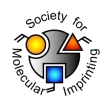
Authors: Fang GZ, Liu GY, Yang YK, Wang S
Article Title: Quartz crystal microbalance sensor based on molecularly imprinted polymer membrane and three-dimensional Au nanoparticles@mesoporous carbon CMK-3 functional composite for ultrasensitive and specific determination of citrinin.
Publication date: 2016
Journal: Sensors and Actuators B: Chemical
Volume: 230
Page numbers: 272-280.
DOI: 10.1016/j.snb.2016.02.053
Alternative URL: http://www.sciencedirect.com/science/article/pii/S0925400516302040
Abstract: Citrinin (CIT) is difficult to measure since only trace levels are present in commercial food products. In this study, a novel three-dimensional (3D) molecularly imprinted quartz crystal microbalance (QCM) sensor for trace CIT detection was constructed by electro-polymerizing o-aminothiophenol on Au nanoparticles@mesoporous carbon CMK-3 (AuNPs@CMK-3) functional composite modified Au electrode surface. Herein, AuNPs@CMK-3 functional composite acted as signal amplifier since the 3D structure and large specific surface area of AuNPs@CMK-3 functional composite were beneficial to increase the amount of effective imprinted sites and subsequently improve the sensitivity of the sensor. The preparation process of the QCM sensor was characterized by scanning electron microscope, transmission electron microscope, cyclic voltammetry and electrochemical impedance spectroscopy. Under the optimal conditions, the proposed sensor showed a linear frequency shift to the concentration of target CIT ranging from 6.0 x 10-9 to 2.0 x 10-7 mol L-1 with a low detection limit of 1.8 x 10-9 mol L-1 (S/N = 3). The sensitive sensor exhibited excellent selective recognition, anti-interference capability, reproducibility and long-term stability, and was successfully applied to analyze trace CIT in cereal samples with satisfactory recoveries, suggesting the proposed sensor is promising for the detection of CIT at trace levels in foods
Template and target information: citrinin, CIT
Author keywords: Quartz crystal microbalance sensor, molecularly imprinted polymer, Citrinin, Au nanoparticles@mesoporous carbon CMK-3



Join the Society for Molecular Imprinting

New items RSS feed
Sign-up for e-mail updates:
Choose between receiving an occasional newsletter or more frequent e-mail alerts.
Click here to go to the sign-up page.
Is your name elemental or peptidic? Enter your name and find out by clicking either of the buttons below!
Other products you may like:
 MIPdatabase
MIPdatabase









